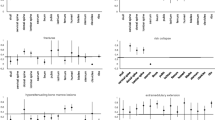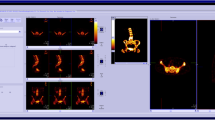Abstract
Objectives
The diagnostic reading of follow-up low-dose whole-body computed tomography (WBCT) examinations in patients with multiple myeloma (MM) is a demanding process. This study aimed to evaluate the diagnostic accuracy and benefit of a novel software program providing rapid-subtraction maps for bone lesion change detection.
Methods
Sixty patients (66 years ± 10 years) receiving 120 WBCT examinations for follow-up evaluation of MM bone disease were identified from our imaging archive. The median follow-up time was 292 days (range 200–641 days). Subtraction maps were calculated from 2-mm CT images using a nonlinear deformation algorithm. Reading time, correctly assessed lesions, and disease classification were compared to a standard reading software program. De novo clinical reading by a senior radiologist served as the reference standard. Statistics included Wilcoxon rank-sum test, Cohen’s kappa coefficient, and calculation of sensitivity, specificity, positive/negative predictive value, and accuracy.
Results
Calculation time for subtraction maps was 84 s ± 24 s. Both readers reported exams faster using subtraction maps (reader A, 438 s ± 133 s; reader B, 1049 s ± 438 s) compared to PACS software (reader A, 534 s ± 156 s; reader B, 1486 s ± 587 s; p < 0.01). The course of disease was correctly classified by both methods in all patients. Sensitivity for lesion detection in subtraction maps/conventional reading was 92%/80% for reader A and 88%/76% for reader B. Specificity was 98%/100% for reader A and 95%/96% for reader B.
Conclusion
A software program for the rapid-subtraction map calculation of follow-up WBCT scans has been successfully tested and seems suited for application in clinical routine. Subtraction maps significantly facilitated reading of WBCTs by reducing reading time and increasing sensitivity.
Key Points
• A novel algorithm has been successfully applied to generate motion-corrected bone subtraction maps of whole-body low-dose CT scans in less than 2 min.
• Motion-corrected bone subtraction maps significantly facilitate the reading of follow-up whole-body low-dose CT scans in multiple myeloma by reducing reading time and increasing sensitivity.






Similar content being viewed by others
Abbreviations
- MM:
-
Multiple myeloma
- PACS:
-
Picture archiving and communication system
- R-ISS:
-
Revised International Staging System
- S&D:
-
Salmon and Durie
- WBCT:
-
Whole-body computed tomography
References
Siegel RL, Miller KD, Jemal A (2019) Cancer statistics, 2019. CA Cancer J Clin. https://doi.org/10.3322/caac.21551
Dimopoulos M, Kyle R, Fermand JP et al (2011) Consensus recommendations for standard investigative workup: report of the International Myeloma Workshop Consensus Panel 3. Blood 117:4701–4705
Hameed A, Brady JJ, Dowling P, Clynes M, O’Gorman P (2014) Bone disease in multiple myeloma: pathophysiology and management. Cancer Growth Metastasis 7:33–42
Kyle RA, Gertz MA, Witzig TE et al (2003) Review of 1027 patients with newly diagnosed multiple myeloma. Mayo Clin Proc 78:21–33
Schabel C, Horger M, Kum S et al (2016) Simplified response monitoring criteria for multiple myeloma in patients undergoing therapy with novel agents using computed tomography. Eur J Radiol 85:2195–2199
Ghosh S, Wadhwa P, Kumar A, Pai K, Seshadri S, Manohar C (2011) Abnormal radiological features in a multiple myeloma patient: a case report and radiological review of myelomas. Dentomaxillofac Radiol 40:513–518
Tosi P (2013) Diagnosis and treatment of bone disease in multiple myeloma: spotlight on spinal involvement. Scientifica (Cairo) 2013:104546
Cocks K, Cohen D, Wisloff F et al (2007) An international field study of the reliability and validity of a disease-specific questionnaire module (the QLQ-MY20) in assessing the quality of life of patients with multiple myeloma. Eur J Cancer 43:1670–1678
Bingham N, Reale A, Spencer A (2017) An evidence-based approach to myeloma bone disease. Curr Hematol Malig Rep. https://doi.org/10.1007/s11899-017-0370-5
Moreau P, San Miguel J, Sonneveld P et al (2017) Multiple myeloma: ESMO clinical practice guidelines for diagnosis, treatment and follow-up. Ann Oncol 28:iv52–iv61
Pawlyn C, Fowkes L, Otero S et al (2016) Whole-body diffusion-weighted MRI: a new gold standard for assessing disease burden in patients with multiple myeloma? Leukemia 30:1446–1448
Lai AYT, Riddell A, Barwick T et al (2019) Interobserver agreement of whole-body magnetic resonance imaging is superior to whole-body computed tomography for assessing disease burden in patients with multiple myeloma. Eur Radiol. https://doi.org/10.1007/s00330-019-06281-x
Hillengass J, Usmani S, Rajkumar SV et al (2019) International myeloma working group consensus recommendations on imaging in monoclonal plasma cell disorders. Lancet Oncol 20:e302–e312
Chantry A, Kazmi M, Barrington S et al (2017) Guidelines for the use of imaging in the management of patients with myeloma. Br J Haematol 178:380–393
(2016) Myeloma: diagnosis and management. (National Institute for Health and Care Excellence: Clinical Guidelines), London, pp nice.org.uk/guidance/ng35
Merz M, Hielscher T, Wagner B et al (2014) Predictive value of longitudinal whole-body magnetic resonance imaging in patients with smoldering multiple myeloma. Leukemia 28:1902–1908
Moreau P, San Miguel J, Ludwig H et al (2013) Multiple myeloma: ESMO clinical practice guidelines for diagnosis, treatment and follow-up. Ann Oncol 24(Suppl 6):vi133–vi137
Caers J, Garderet L, Kortum KM et al (2018) European Myeloma Network recommendations on tools for the diagnosis and monitoring of multiple myeloma: what to use and when. Haematologica 103:1772–1784
Pianko MJ, Terpos E, Roodman GD et al (2014) Whole-body low-dose computed tomography and advanced imaging techniques for multiple myeloma bone disease. Clin Cancer Res 20:5888–5897
Ueno M, Aoki T, Murakami S et al (2018) CT temporal subtraction method for detection of sclerotic bone metastasis in the thoracolumbar spine. Eur J Radiol 107:54–59
Horger M, Fritz J, Thaiss WM et al (2018) Comparison of qualitative and quantitative CT and MRI parameters for monitoring of longitudinal spine involvement in patients with multiple myeloma. Skeletal Radiol 47:351–361
Sakamoto R, Yakami M, Fujimoto K et al (2017) Temporal subtraction of serial CT images with large deformation diffeomorphic metric mapping in the identification of bone metastases. Radiology 285:629–639
Iwano S, Ito R, Umakoshi H et al (2017) Thoracic temporal subtraction three dimensional computed tomography (3D-CT): screening for vertebral metastases of primary lung cancers. PLoS One 12:e0170309
Horger M, Thaiss WM, Wiesinger B et al (2017) Longitudinal computed tomography monitoring of pelvic bones in patients with breast cancer using automated bone subtraction software. Invest Radiol 52:288–294
Horger M, Ditt H, Liao S et al (2017) Automated “bone subtraction” image analysis software package for improved and faster CT monitoring of longitudinal spine involvement in patients with multiple myeloma. Acad Radiol 24:623–632
Onoue K, Nishio M, Yakami M et al (2019) CT temporal subtraction improves early detection of bone metastases compared to SPECT. Eur Radiol. https://doi.org/10.1007/s00330-019-06107-w
Bossuyt PM, Reitsma JB, Bruns DE et al (2015) STARD 2015: an updated list of essential items for reporting diagnostic accuracy studies. Radiology 277:826–832
Durie BG, Kyle RA, Belch A et al (2003) Myeloma management guidelines: a consensus report from the Scientific Advisors of the International Myeloma Foundation. Hematol J 4:379–398
König L, Rühaak J, Derksen A, Lellmann J (2018) A matrix-free approach to parallel and memory-efficient deformable image registration. SIAM J Sci Comput 40:B858–B888
Fischer B, Modersitzki J (2003) Curvature based image registration. J Math Imaging Vision 18:81–85
Haber E, Modersitzki J (2006) Intensity gradient based registration and fusion of multi-modal images. In: Larsen R, Nielsen M, Sporring J (Eds) Medical Image Computing and Computer-Assisted Intervention – MICCAI 2006. MICCAI 2006. Lecture Notes in Computer Science, vol 4191. Springer, Berlin, Heidelberg
Pomerantz SM, White CS, Krebs TL et al (2000) Liver and bone window settings for soft-copy interpretation of chest and abdominal CT. AJR Am J Roentgenol 174:311–314
Heindel W, Gubitz R, Vieth V, Weckesser M, Schober O, Schafers M (2014) The diagnostic imaging of bone metastases. Dtsch Arztebl Int 111:741–747
Ruhaak J, Polzin T, Heldmann S et al (2017) Estimation of large motion in lung CT by integrating regularized keypoint correspondences into dense deformable registration. IEEE Trans Med Imaging 36:1746–1757
Grob D, Oostveen L, Ruhaak J et al (2019) Accuracy of registration algorithms in subtraction CT of the lungs: a digital phantom study. Med Phys 46:2264–2274
Homann G, Weisel K, Mustafa DF, Ditt H, Nikolaou K, Horger M (2015) Improvement of diagnostic confidence for detection of multiple myeloma involvement of the ribs by a new CT software generating rib unfolded images: comparison with 5- and 1-mm axial images. Skeletal Radiol 44:971–979
Scholtz JE, Wichmann JL, Kaup M et al (2015) First performance evaluation of software for automatic segmentation, labeling and reformation of anatomical aligned axial images of the thoracolumbar spine at CT. Eur J Radiol 84:437–442
Hardisty M, Gordon L, Agarwal P, Skrinskas T, Whyne C (2007) Quantitative characterization of metastatic disease in the spine. Part I. Semiautomated segmentation using atlas-based deformable registration and the level set method. Med Phys 34:3127–3134
O’Connor SD, Yao J, Summers RM (2007) Lytic metastases in thoracolumbar spine: computer-aided detection at CT—preliminary study. Radiology 242:811–816
Skrinskas T, Clemons M, Freedman O, Weller I, Whyne CM (2009) Automated CT-based analysis to detect changes in the prevalence of lytic bone metastases from breast cancer. Clin Exp Metastasis 26:97–103
Hammon M, Dankerl P, Tsymbal A et al (2013) Automatic detection of lytic and blastic thoracolumbar spine metastases on computed tomography. Eur Radiol 23:1862–1870
Akasaka T, Yakami M, Nishio M et al (2019) Detection of suspected brain infarctions on CT can be significantly improved with temporal subtraction images. Eur Radiol 29:759–769
Kosmala A, Weng AM, Krauss B, Knop S, Bley TA, Petritsch B (2018) Dual-energy CT of the bone marrow in multiple myeloma: diagnostic accuracy for quantitative differentiation of infiltration patterns. Eur Radiol 28:5083–5090
Acknowledgments
The authors warmly thank Prof. Inke König for her skillful statistical advice.
Funding
The authors state that this work has not received any funding.
Author information
Authors and Affiliations
Corresponding author
Ethics declarations
Guarantor
The scientific guarantor of this publication is Prof. Dr. Alex Frydrychowicz, Department of Radiology and Nuclear Medicine, UKSH, Campus Lübeck.
Conflict of interest
The authors declare that they have no conflict of interest.
Statistics and biometry
Prof. Inke König kindly provided statistical advice for this manuscript.
Informed consent
Written informed consent was waived by the institutional review board.
Ethical approval
Institutional review board approval was obtained.
Methodology
• retrospective
• diagnostic or prognostic study
• performed at one institution
Additional information
Publisher’s note
Springer Nature remains neutral with regard to jurisdictional claims in published maps and institutional affiliations.
Rights and permissions
About this article
Cite this article
Sieren, M.M., Brenne, F., Hering, A. et al. Rapid study assessment in follow-up whole-body computed tomography in patients with multiple myeloma using a dedicated bone subtraction software. Eur Radiol 30, 3198–3209 (2020). https://doi.org/10.1007/s00330-019-06631-9
Received:
Revised:
Accepted:
Published:
Issue Date:
DOI: https://doi.org/10.1007/s00330-019-06631-9




